Content
All issues / Volume 18 (2024) / Issue 6 (June)
Ming Qiu Zhang
Vol. 18., No.6., Pages 559-560, 2024
DOI: 10.3144/expresspolymlett.2024.41
Vol. 18., No.6., Pages 559-560, 2024
DOI: 10.3144/expresspolymlett.2024.41
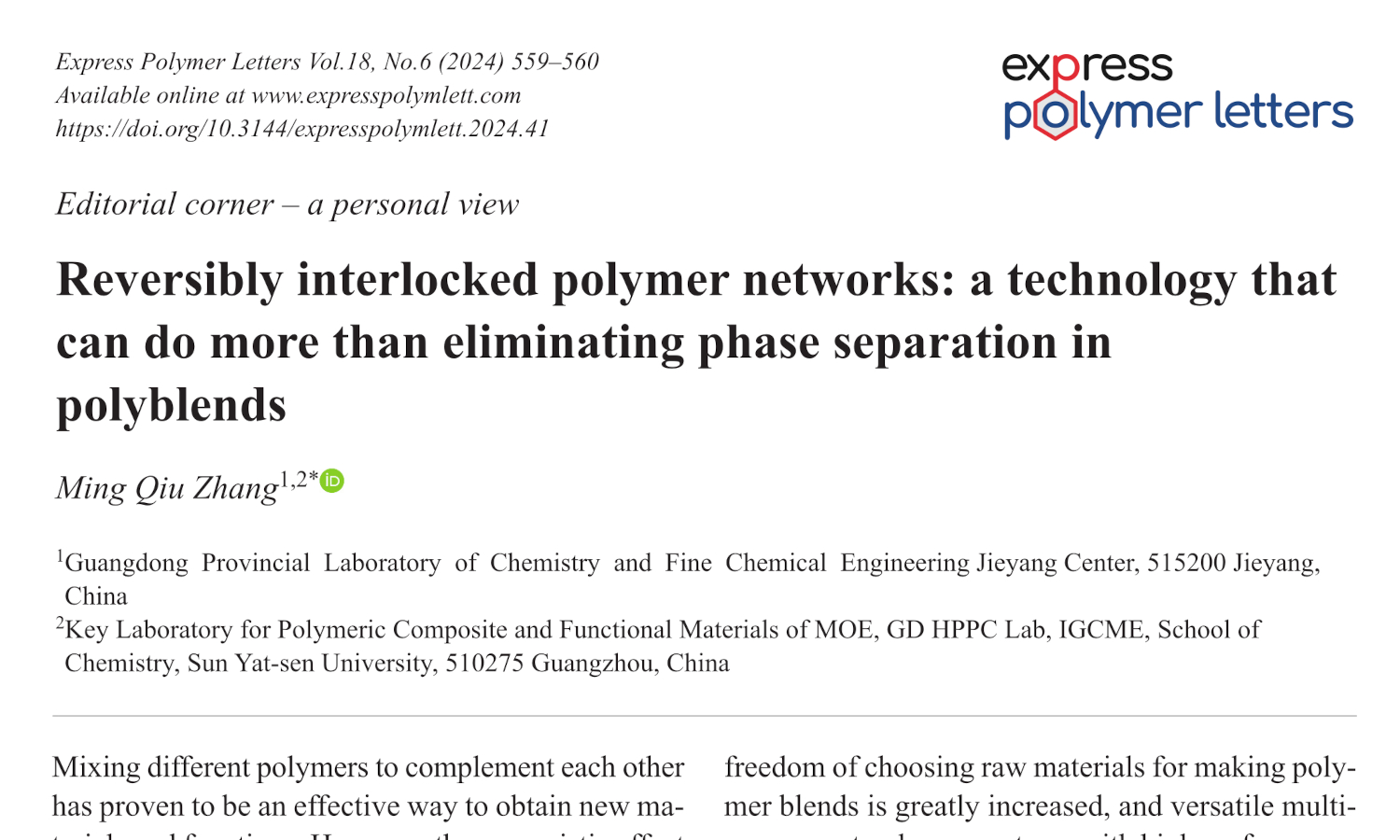
This is an editorial article. It has no abstract.
Rogerio Ramos de Sousa Junior, Guilherme Elias Saltarelli Garcia, Leonardo Dalseno Antonino, Júlia Rocha Gouveia, Demetrio Jackson dos Santos, Danilo Justino Carastan
Vol. 18., No.6., Pages 561-574, 2024
DOI: 10.3144/expresspolymlett.2024.42
Vol. 18., No.6., Pages 561-574, 2024
DOI: 10.3144/expresspolymlett.2024.42
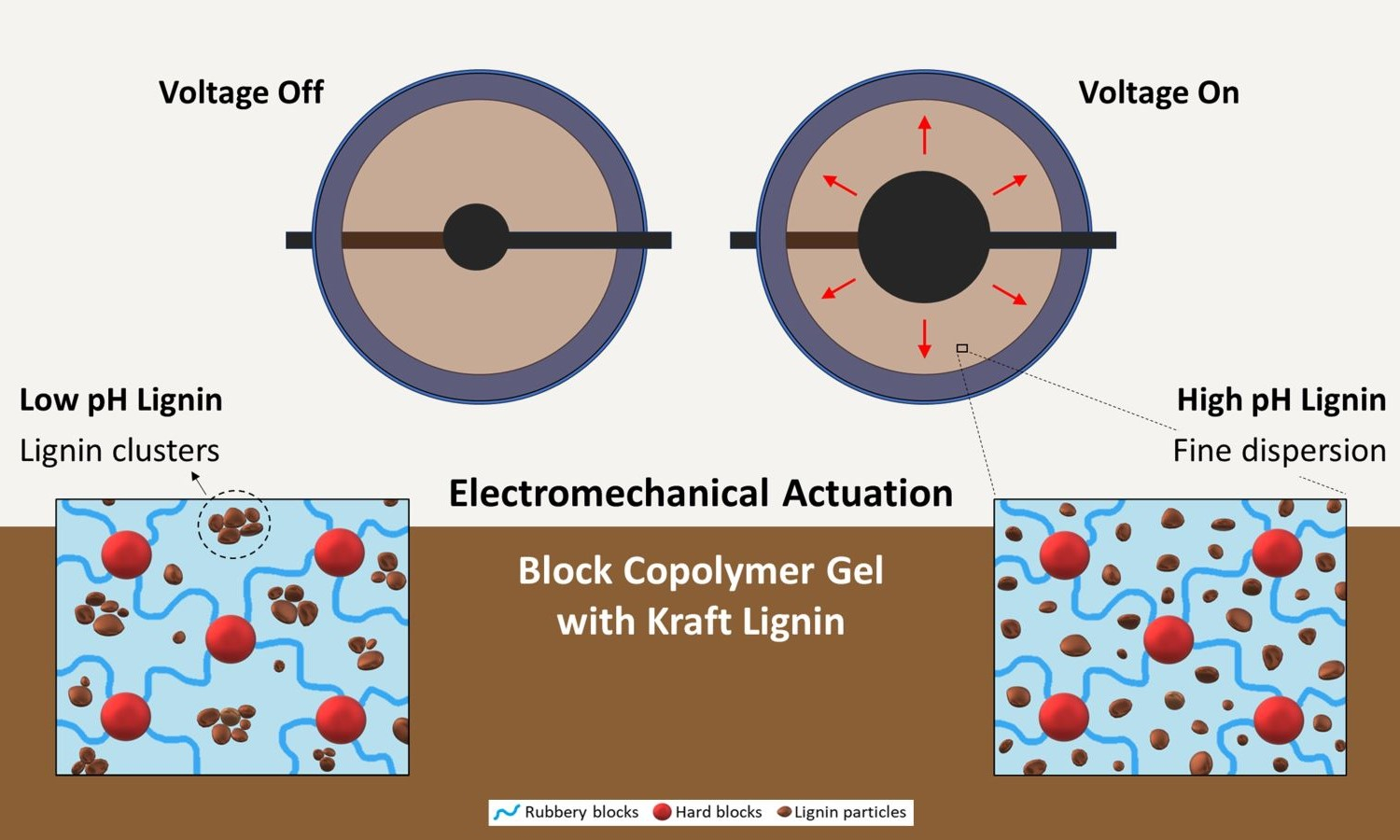
Thermoplastic
elastomer gels based on styrenic triblock copolymers have been increasingly
used as dielectric elastomers, particularly due to the possibility of tailoring
their properties based on their composition. However, these materials have a
low relative permittivity, primarily attributed to their low dipole moment.
Consequently, this characteristic poses a challenge for their application as
dielectric elastomers. In this work, we aim to assess the impact of adding
kraft lignin on the dielectric properties of thermoplastic elastomer gels.
Additionally, we investigate the effects of kraft lignin dispersion on their
viscoelastic and mechanical properties. For this purpose, we used two types of
kraft lignin: acidic and alkaline (ac-KL and alk-KL). The alk-KL demonstrated
higher dispersibility in the polymer, mainly attributed to the deprotonation of
its structure during its production process. As a result, the dielectric
elastomer with alk-KL showed a 50% increase in relative permittivity compared
to the pristine polymer without compromising its mechanical and viscoelastic
properties. Moreover, these samples demonstrated a greater actuation strain
capability in response to an electrical stimulus. Thus, the incorporation of
lignin demonstrates promise as a valuable reinforcement in the development of
advanced dielectric materials, enhancing their electro-mechanical performance.
Xianli Sun, Jiahao Xu, Xiaoke Zhi, Jingpeng Zhang, Kangwei Hou, Yuhan Bian, Xiaolin Li, Li Wang, Guangchuan Liang
Vol. 18., No.6., Pages 575-591, 2024
DOI: 10.3144/expresspolymlett.2024.43
Vol. 18., No.6., Pages 575-591, 2024
DOI: 10.3144/expresspolymlett.2024.43

As a key component of lithium-ion batteries, a separator with excellent electrolyte wettability and good thermal stability has an important impact on the overall performance of lithium-ion batteries. Herein, a PVDF/sepiolite electrospun layer was coated on one side of the PP separator via electrospinning technology to prepare the composite separator (xMS-PVDF@PP) with sepiolite nanofibers modified with vinyltriethoxysilane (VTES) to ameliorate their dispersibility and compatibility with PVDF polymer matrix. The effect of modified sepiolite addition amounts on the physical and electrochemical properties of composite separator was intensively studied. It is found that the as-prepared xMS-PVDF@PP composite separator displays enhanced porosity, electrolyte uptake, thermal stability and Li+ ion transport kinetics than pristine PP separator. Specifically, Li|LiFePO4 battery with 20MS-PVDF@PP as separator shows the best rate and cycling performance, with a specific discharge capacity of 115.3 mAh·g–1 at 10C rate and a capacity retention rate of 97.06% after 200 cycles at 1C rate. The sepiolite in the electrospun layer can immobilize PF6– anion to facilitate the uniform distribution of Li+ ions and then inhibit the lithium dendrite growth, as well as absorb HF to alleviate Fe2+ dissolution from LiFePO4 cathode, thereby further improving the electrochemical performance of LiFePO4 battery.
Forough Abbasi Shahir, Zahed Ahmadi, Sayed Mahmood Rezaee Darvishi
Vol. 18., No.6., Pages 592-606, 2024
DOI: 10.3144/expresspolymlett.2024.44
Vol. 18., No.6., Pages 592-606, 2024
DOI: 10.3144/expresspolymlett.2024.44
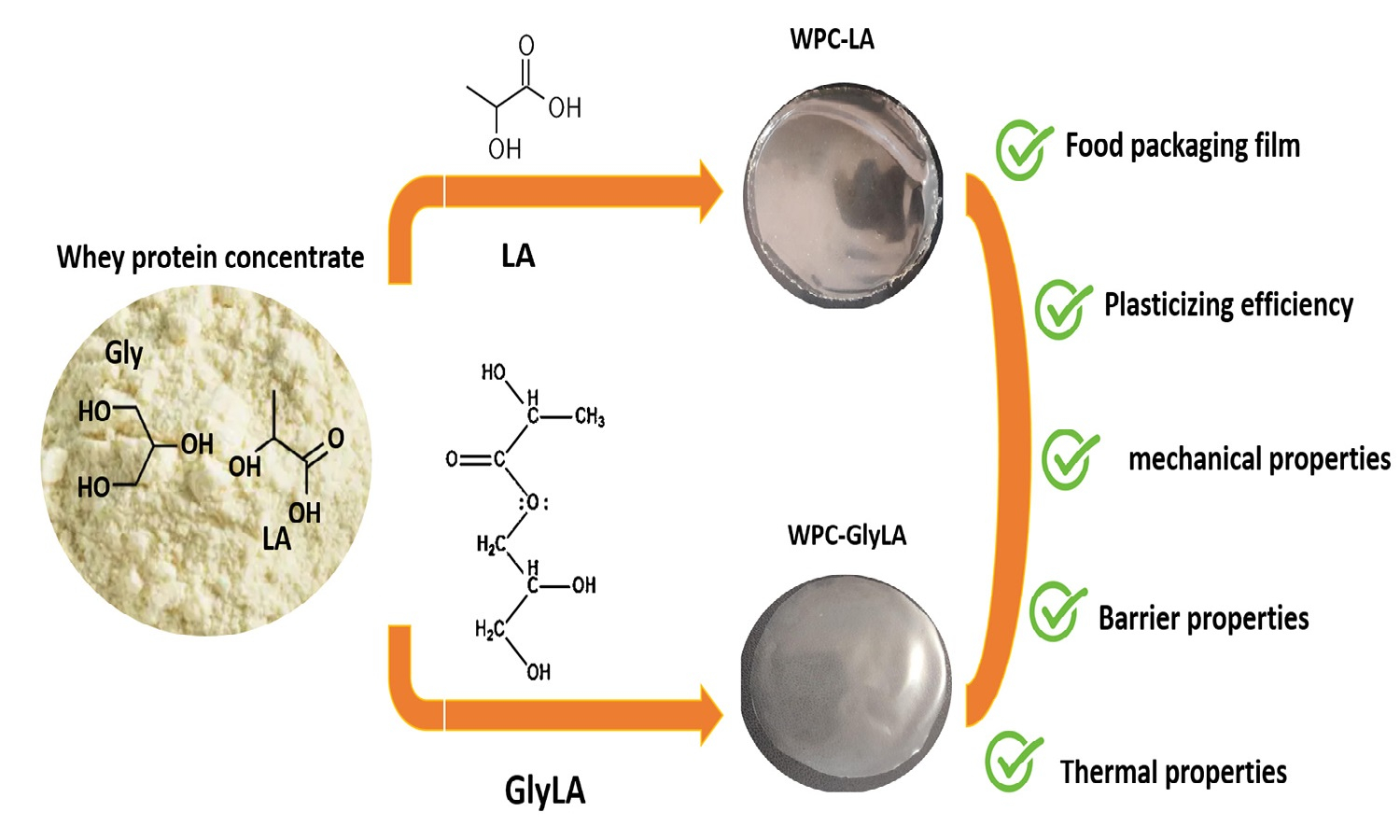
Glyceryl lactate (GlyLA) was synthesized through the esterification of glycerol (Gly) and lactic acid (LA) to plasticize whey protein concentrate (WPC) films with three different ratios of WPC to plasticizer (85, 90, and 100% w/w). LA was also introduced as a new plasticizer of whey protein films and compared in similar contents. Gly-plasticized films were also used as control groups. The synthesized GlyLA, including compatible esterification degree with WPC, was characterized by Fourier transform infrared Spectroscopy (FTIR) and hydrogen nuclear magnetic resonance spectroscopy (H-NMR) analyses. Then, the plasticizing effect of different types of plasticizers on the optical, thermal, mechanical, and water resistivity properties of the prepared films was evaluated. FTIR in attenuated total reflectance (ATR), Differential Scanning Calorimetry (DSC), tensile measurements, and cup method were also employed to examine the molecular structure, transition temperatures, mechanical resistivity, and water vapor permeability (WVP) of the modified films. The results showed a lower glasstransition temperature (Tg) and better ductility. By Increasing plasticizer content, solubility and WVP were increased in all groups. Furthermore, WPC-based films plasticized with 80 or 90% w/w of LA and GlyLA exhibited not only higher tensile strength and flexibility but also remarkably lower WVP than Gly plasticized films, turning them into potential alternatives for application as food packaging.
Jolanta Konieczkowska, Klaudia Nocoń-Szmajda, Agnieszka Ciemięga
Vol. 18., No.6., Pages 607-622, 2024
DOI: 10.3144/expresspolymlett.2024.45
Vol. 18., No.6., Pages 607-622, 2024
DOI: 10.3144/expresspolymlett.2024.45
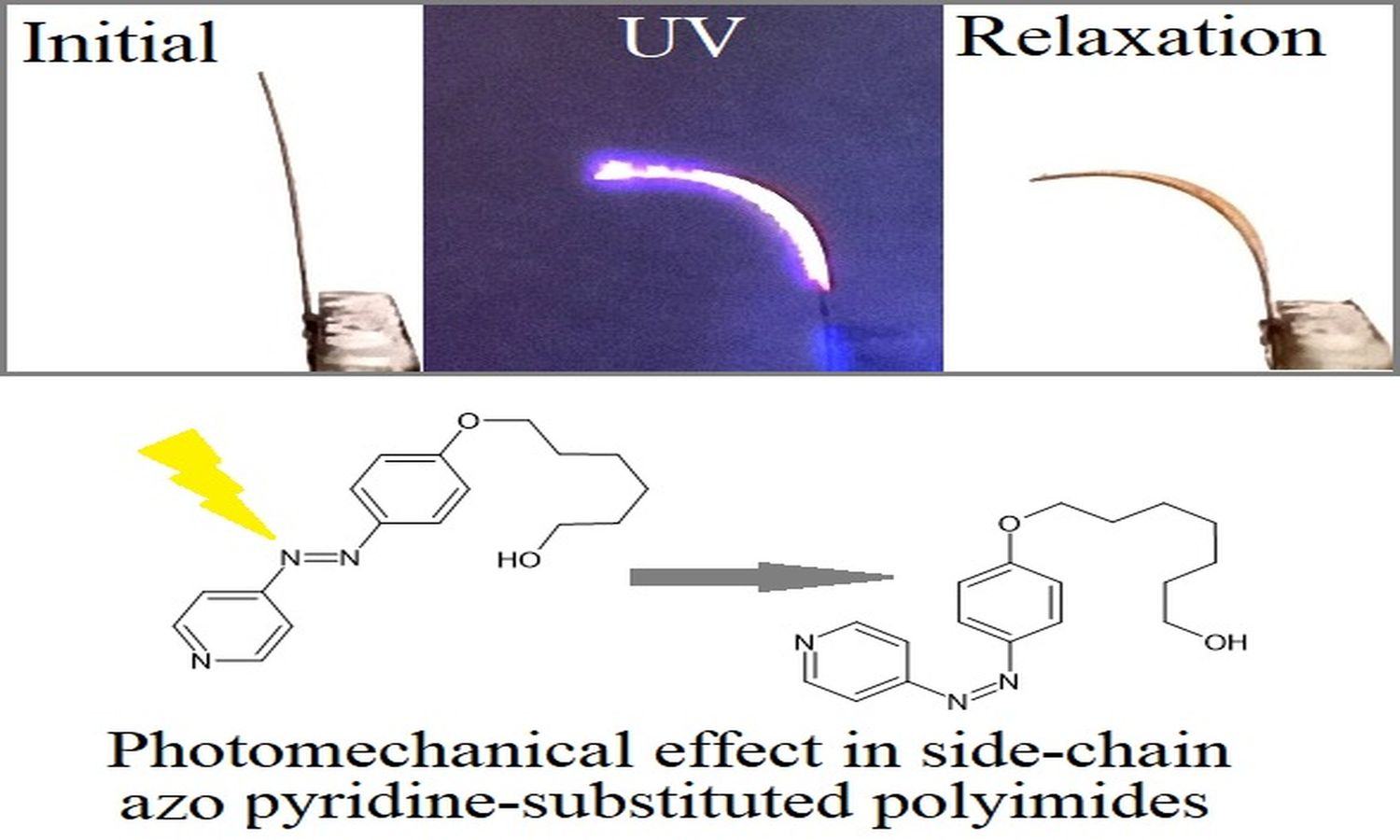
The paper presents the photomechanical effect generated in new azo side-chain polyimides synthesized through a post-functionalization strategy involving the Mitsunobu reaction. Prepared azo polyimide foils were irradiated by a 405 nm diode-laser beam (intensity, I = 100 mW/cm2; polarization, Eǀǀx) for the generation of the photomechanical effect. Despite the low content of azo chromophore (substitution of the hydroxyl group was in the range of 7–35%) and thick cantilevers (thickness ~35 μm), bending angles were in the range of 30–40°. Thermal unbending was not observed for 12 months after turning off the excitation light. Our investigation showed that, despite the low content of azo chromophore, it is possible to achieve photodeformation under polarized light. To the best of our knowledge, this is the first example of the photomechanical response of azo pyridine polymers.
Azizon Kaesaman, Suwit Chiponbarn, Charoen Nakason
Vol. 18., No.6., Pages 623-637, 2024
DOI: 10.3144/expresspolymlett.2024.46
Vol. 18., No.6., Pages 623-637, 2024
DOI: 10.3144/expresspolymlett.2024.46
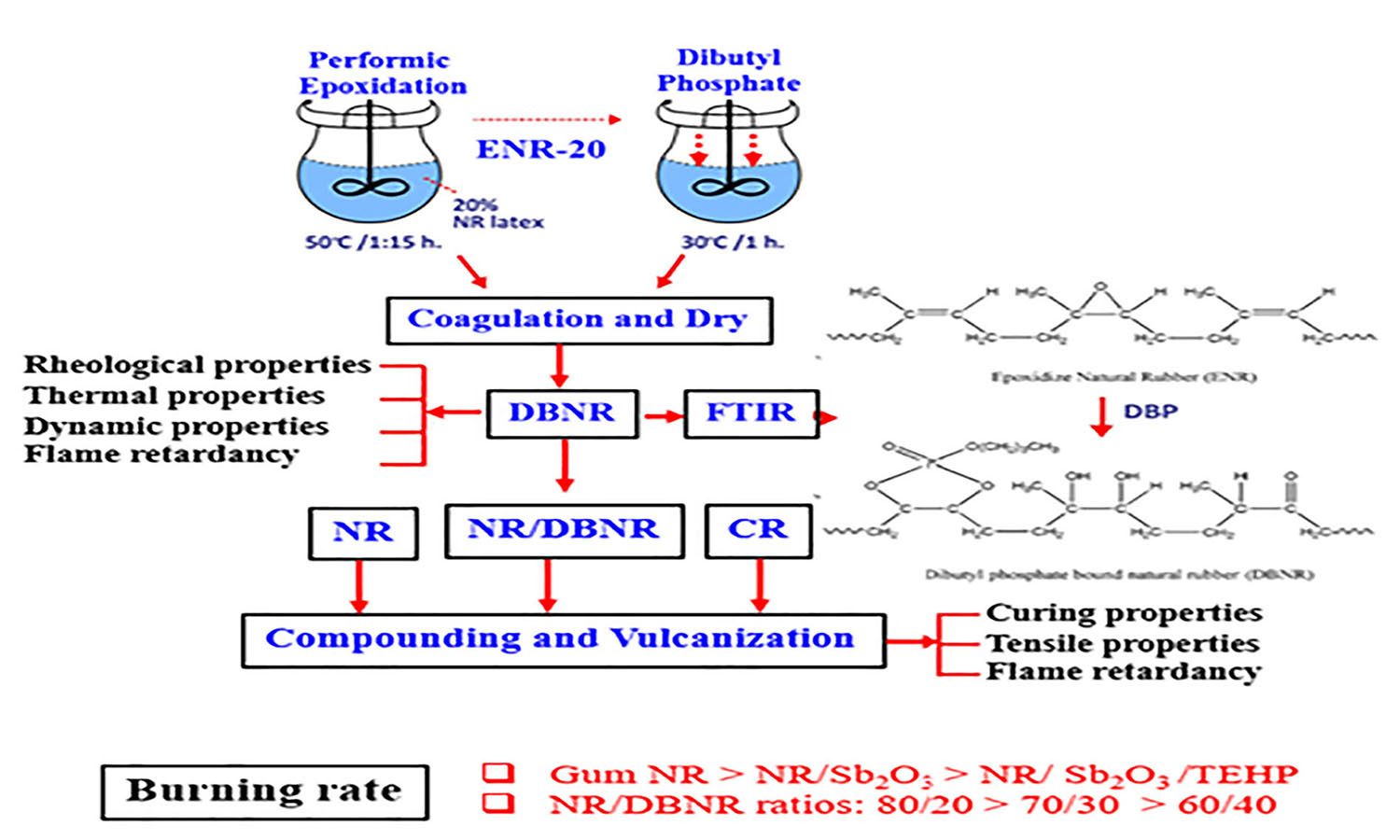
Dibutyl phosphate-bound natural rubber (DBNR) was prepared by reacting epoxidized natural rubber with 20 mol% (ENR-20) with dibutyl phosphate in a latex medium. Fourier transform infrared spectroscopy (FTIR) was used to confirm the molecular structures of ENR-20 and DBNR and to quantify the epoxide contents. The shear flows and thermal properties of DBNR were then characterized and compared with ENR-20 and natural rubber (NR). The DBNR exhibited the lowest viscosity curves, but it depicted the highest glass transition temperature (Tg) and residue from thermogravimetric evaluation, indicating higher thermal resistance. Subsequently, different NR/DBNR blend ratios were compounded, with and without flame resistance additives, compared with unmodified NR and chloroprene rubber (CR) compounds. We found that all natural rubber compounds exhibited reversion behavior due to the breakage of newly formed sulfidic bonds. However, chloroprene rubber showed marching cured curves, as evidenced by the increasing torque with prolonged testing time. Additionally, antimony trioxide retarded the curing reaction of NR, while tris(2-ethylhexyl) phosphate accelerated it. Therefore, the combination of these additives synergists with the intrinsic flame retardant properties of DBNR. The study revealed that the burning rate of NR/DBNR blends, exhibited very high flame resistance capability compared to gum NR and NR compounded with flame resistance additives.
Milanta Tom, Sabu Thomas, Bastien Seantier, Yves Grohens, Mohamed Pulikaparambil Kochaidrew, Ramakrishnan Subramanian, Tapas Ranjan Mohanty, Henri Vahabi, Hanna Joseph Maria, Jibin Keloth Paduvilan, Martin George Thomas
Vol. 18., No.6., Pages 638-655, 2024
DOI: 10.3144/expresspolymlett.2024.47
Vol. 18., No.6., Pages 638-655, 2024
DOI: 10.3144/expresspolymlett.2024.47

The augmented demand for
sustainable nanocomposites has paved the way to explore naturally derived
materials. Nanocellulose, with its bountiful sources and inherent properties,
ranks top in the list of biofillers with a perspective of reducing the carbon
footprint. A systematic study is required to understand the reinforcing effect
of various types of nanocellulose. In the present work, we selected three types
of nanocellulose, i.e.,
cellulose nanocrystal (CNC), cellulose nanofiber (CNF) and microfibrillated
cellulose (MFC), to investigate the effect of geometrical structure on the
properties of unvulcanized natural rubber (NR). Incorporating these fillers
improved the tensile strength and modulus of natural rubber films significantly
through reinforcement via filler network structure. The reinforcing effect of
CNF was found to be higher compared to CNC and MFC, where an increase of 3.85
MPa in tensile strength from the neat sample was obtained. More uniform
dispersion was evident through transmission electron microscopy, atomic force
microscopy and Raman imaging for CNF in the rubber matrix. The structural
properties were determined using Raman spectra and X-ray diffraction. The rheological
studies revealed a good interaction between filler and NR. The work presented
comprehensively compares different types of nanocellulose as reinforcing filler
in NR matrix, which will help the researchers select an ideal type for their
specific application and, thus, the proper usage of renewable resources,
leading to sustainability and a circular economy.
André da Silva Siqueira, Natália Ferreira Braga, Pablo Andrés Riveros Muñoz, Lucas Freitas de Freitas, Aryel Heitor Ferreira, Guilhermino Jose Macêdo Fechine
Vol. 18., No.6., Pages 656-672, 2024
DOI: 10.3144/expresspolymlett.2024.48
Vol. 18., No.6., Pages 656-672, 2024
DOI: 10.3144/expresspolymlett.2024.48
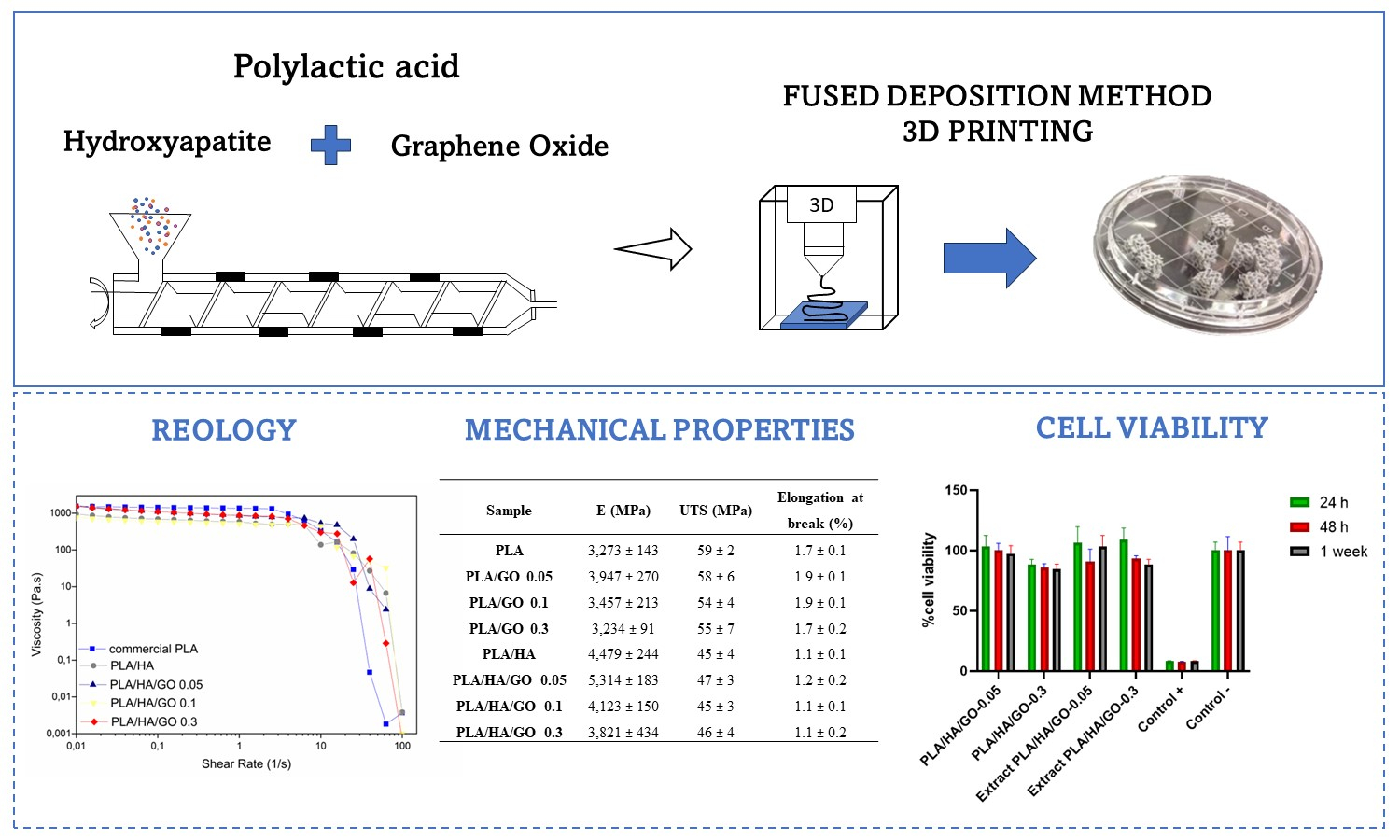
Extensive research and practical applications have been conducted within the biomaterials domain, focusing on polylactic acid (PLA) based composite. These composites have been explored for their favorable attributes, such as excellent processability, biodegradability, and bioactivity properties, but still lack mechanical properties. In this work, PLA-based nanocomposites were prepared by incorporating hydroxyapatite (HA) and graphene oxide (GO) via melt mixing (extruder). Filaments were obtained to develop scaffolds through 3D printing, utilizing the fused deposition method (FDM). The GO was produced using Hummer’s method and characterized by X-ray diffraction (XRD), thermogravimetric analysis (TGA), and Raman Spectroscopy. The composites were analyzed using Fourier-transform infrared spectroscopy (FTIR), molecular weight, contact angle measurements, and thermal, mechanical, and rheological analysis. Adding only 0.05 wt% of GO to both PLA and PLA/HA resulted in enhancements in mechanical properties, particularly tensile strength, and significantly modified the surface properties of the materials studied. Specifically, formulation involving PLA/HA/GO was the only one to exhibit rheological properties compatible with the scaffold production process via FDM. These specific formulations were also investigated regarding cytotoxicity, and the presence of GO induces good cytocompatibility in mouse osteoblast cells (MC3T3). These results suggest that FDM technology can be used to fabricate higher-performance (mechanical and biological) scaffolds for tissue engineering.


